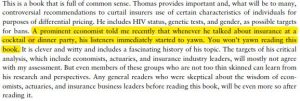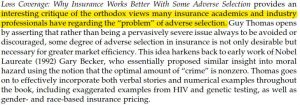 ** Winner, Kulp-Wright Book Award for 2019 ** (awarded by American Risk and Insurance Association for most significant book in the risk management and insurance field published in 2017).
** Winner, Kulp-Wright Book Award for 2019 ** (awarded by American Risk and Insurance Association for most significant book in the risk management and insurance field published in 2017).
‘This is a serious book which challenges some of the conventional thinking of actuaries and economists about adverse selection in insurance, and does so with justification; they would do well to take the author’s views into account.’ David Wilkie, InQA Limited and Heriot Watt University, Scotland
‘Guy Thomas challenges the orthodox views held by the insurance industry, actuaries, and economists concerning the problem of adverse selection. He makes his case that a little adverse selection is actually a good thing in a sensible, pragmatic, and compelling manner. His critical insights about the debates on restricting risk classification in insurance should be essential reading for policy makers.’ Michael Hoy, University of Guelph, Canada
‘Despite dramatic warnings, insurance companies continue to prosper despite bans on gender rating, genetic testing, racial and other discriminations in setting policy terms. This thought-provoking book explains why. The author makes a convincing case for even tighter regulation of allowable risk classifications to enhance the welfare of society of a whole – especially timely now as 1-in-5 proposers for life insurance are not accepted at standard rates.’ Shane Whelan, FFA, FSAI, Former Managing Editor of the British Actuarial Journal
‘Actuaries traditionally see nothing but danger in adverse selection. Guy Thomas, an actuary himself, sees opportunity. Using the concept of loss coverage, Thomas challenges the conventional wisdom of how economists model insurance markets, much of which, he sets out to show, is more myth than reality. Lucidly written and sure to get the reader thinking afresh.’ Angus Macdonald, Heriot Watt University, Scotland

Michael Hoy, University of Guelph in Annals of Actuarial Science (full text)

Bill Ferguson, University of Louisiana in Journal of Risk and Insurance (full text)
Cambridge University Press page Amazon page